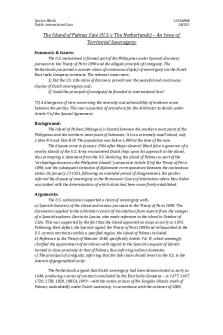Case study Rabbit Island Experiment PDF

| Title | Case study Rabbit Island Experiment |
|---|---|
| Course | Microbiology |
| Institution | North Carolina A&T State University |
| Pages | 2 |
| File Size | 65.6 KB |
| File Type | |
| Total Downloads | 31 |
| Total Views | 132 |
Summary
rabbit island case study...
Description
Case study: Rabbit Island Experiment 1. The data from the experiment Dr. Trudeau describes is shown below in Figure 1. Graphs like Figure 1 are called survival curves. Write a narration of the # gure describing the results of the experiment. Explain why the rabbits are emaciated in groups 1 and 2. (Please note: What Dr. Trudeau called Experiments 1, 2, and 3 are more like what modern scientists would call treatment groups 1, 2, and 3, and that terminology is used in Figure 1.)
The rabbits in groups one and two are emaciated because they were placed in a dark confined space deprived of light, air, and exercise. Group 3 was healthier as opposed to groups 1 and 2 because they had access to exercise and plenty of food. 2. Use your results to write an overall conclusion to the Rabbit Island Experiment. Also develop an answer to each of Dr. Trudeau’s questions.
It can be concluded from Dr. Trudeau’s experiment that if you have adequate food supply, sunlight, and exercise your survival rates will increase. Question 1:What results ensue when both bacillary infection and unhygienic surroundings are made to coexist in tuberculosis? When bacillary infection and unhygienic surroundings are present for a living thing infected with tuberculosis; they are seen to have lower survival rates as shown in experiment 1. Question 2: Are unhygienic surroundings when every known precaution has been taken to exclude the bacillus sufficient of themselves to bring about the disease? No, in terms of this experiment the uninfected rabbits in group 2 that were exposed to unhealthy conditions were showed to not have any signs indicating bacillary infection Question 3:Is bacillary infection invariably progressive in animals placed under the best conditions of environment attainable? No, infection is not invariably progressive in animals placed under the best conditions environment. The rabbits in group 3 though infected with bacillary were thriving and all but one of the rabbits survived.
3. Do Dr. Trudeau’s results support the germ theory of infection? Why or why not?
Dr. Trudeau's results support the germ theory of infection because the theory is essentially infectious diseases are caused by germs, and the experiments show that if the germ does not
come into contact with the rabbit they can’t be infected Tuberculosis. The 2nd experiment showed that rabbits didn’t spontaneously become infected as they weren’t in contact with the germ. 4. What do the data suggest might be good environmental conditions for tuberculosis patients? The best conditions for tuberculosis patients would be somewhere with abundant sunlight, fresh air, exercise, and food.
5. What might be the effect of crowding on the effective exposure rate of individual animals to MTb? (Hint: Would you rather board an airplane for a 3-hour trip where 2 out of 300 passengers had the flu or board an airplane where 200 out of 300 passengers had the flu?)
Crowding may allow for an effective exposure rate of individual animals to MTb because of the close proximity. Chances of contracting Tuberculosis would be greater in crowded and poorly ventilated conditions....
Similar Free PDFs

Easter Island Study Guide
- 7 Pages

Gizmo Rabbit Population Season
- 6 Pages

Tesco-Case-Study - Case Study
- 3 Pages

Rabbit Digestive System
- 5 Pages

Rabbit hole analysis
- 4 Pages

Case 7 - Case Study
- 1 Pages

Case 9 - Case study
- 6 Pages

Case-7 - case study
- 5 Pages

Tesla Case - CASE STUDY
- 22 Pages

CASE Accenture - case study
- 3 Pages

Rabbit Hole film response
- 2 Pages

Schizophrenia. case - case study
- 4 Pages

Meiorin case - Case Study
- 2 Pages
Popular Institutions
- Tinajero National High School - Annex
- Politeknik Caltex Riau
- Yokohama City University
- SGT University
- University of Al-Qadisiyah
- Divine Word College of Vigan
- Techniek College Rotterdam
- Universidade de Santiago
- Universiti Teknologi MARA Cawangan Johor Kampus Pasir Gudang
- Poltekkes Kemenkes Yogyakarta
- Baguio City National High School
- Colegio san marcos
- preparatoria uno
- Centro de Bachillerato Tecnológico Industrial y de Servicios No. 107
- Dalian Maritime University
- Quang Trung Secondary School
- Colegio Tecnológico en Informática
- Corporación Regional de Educación Superior
- Grupo CEDVA
- Dar Al Uloom University
- Centro de Estudios Preuniversitarios de la Universidad Nacional de Ingeniería
- 上智大学
- Aakash International School, Nuna Majara
- San Felipe Neri Catholic School
- Kang Chiao International School - New Taipei City
- Misamis Occidental National High School
- Institución Educativa Escuela Normal Juan Ladrilleros
- Kolehiyo ng Pantukan
- Batanes State College
- Instituto Continental
- Sekolah Menengah Kejuruan Kesehatan Kaltara (Tarakan)
- Colegio de La Inmaculada Concepcion - Cebu


